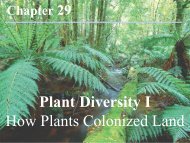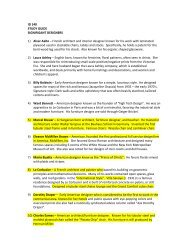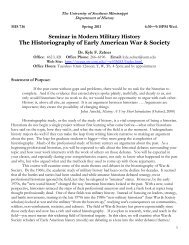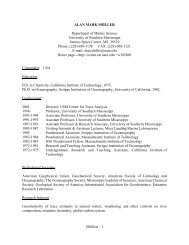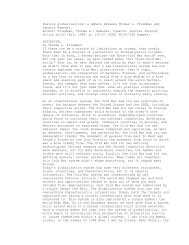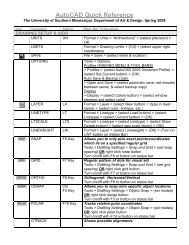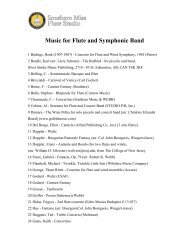Get PDF (1214K) - Wiley Online Library
Get PDF (1214K) - Wiley Online Library
Get PDF (1214K) - Wiley Online Library
Create successful ePaper yourself
Turn your PDF publications into a flip-book with our unique Google optimized e-Paper software.
Rickettsia endosymbiont in water beetles<br />
205<br />
Fig. 2. FISH double hybridization of the<br />
Rickettsia symbiont on tissue (fatbody) crosssection<br />
from Deronectes platynotus (a–c, scale<br />
bar = 40 mm) and Deronectes aubei (d–f, scale<br />
bar = 20 mm). The left panels (a, d) show FISH<br />
with the probe Cy3-Rick_B1, which visualizes the<br />
Rickettsia symbiont, while middle panels (b, e)<br />
show FISH with the probe Cy5-EUB338, which<br />
recognizes diverse eubacteria universally. The<br />
overlay (c, f) does not show other bacteria.<br />
Double hybridization performed with Rick_B1, together<br />
with the universal probe EUB338, showed the absence of any<br />
other kind of endosymbiotic bacteria (Fig. 2), with the<br />
exception of gut bacteria inside adult and larval specimens<br />
of Deronectes. FISH accomplished with EUB388 II and<br />
EUB338 III did not show any positive signals (data not<br />
shown).<br />
Electron microscopy of the Rickettsia symbiont<br />
Ultrastructural examinations of male accessory glands of<br />
D. platynotus revealed coccobacillary rickettsiae that were<br />
observed free in the cytoplasm (Fig. 3a). Most rickettsiae<br />
ranged from 0.35 mm in width to 0.65 mm in length. Rickettsiae<br />
were delineated by an inner periplasmatic membrane,<br />
a periplasmatic space and a trilaminar cell wall with a thicker<br />
inner leaflet, characteristic of the genus Rickettsia. ARickettsia-typical<br />
slime layer or an electron-translucent zone, up<br />
to 60 nm thick, surrounded the cell wall and separated the<br />
bacterium from the cytoplasm of the host cell (Fig. 3b).<br />
Isolated bacteria were also found in the musculature,<br />
enclosing the male accessory gland (Fig. 3c). Some of the<br />
symbionts were much longer and had a ‘filamentous’<br />
appearance. They could be as long as 2.74 mm (Fig. 3d).<br />
Phylogenetic analysis of the Rickettsia symbiont<br />
Phylogenetic analyses on the basis of the 16S rRNA gene<br />
sequence revealed that Rickettsia sp. from Deronectes belong<br />
neither to the ‘spotted fever group’ nor the ‘typhus group,’<br />
but was placed within the ancestral group (100% bootstrap<br />
support) (Fig. 4). Clones of the endosymbiotic bacteria of<br />
D. platynotus, D. aubei and D. delarouzei were placed in the<br />
clade with R. limoniae, Rickettsia endosymbionts of Cerobasis<br />
guestifalica (Psocoptera, Trogiidae) and Lutzomyia apache<br />
(Diptera, Psychodinae), whereas Rickettsia sp. of D. semirufus<br />
cluster basal with rickettsiae from leeches. By phylogenetic<br />
analysis based on the gltA gene (Fig. 5), the Rickettsia strain<br />
from Deronectes clustered with Rickettsia endosymbionts of<br />
L. apache and different spider species in a terminal group<br />
(99% bootstrap support) that is distinctly separated from<br />
other Rickettsia species of the spotted fever, typhus and bellii<br />
groups. The phylogenetic position of Deronectes rickettsiae<br />
was the same in the 16S rRNA gene and gltA trees when the<br />
maximum-likelihood, parsimony and distance methods<br />
were used (data not shown). Only the position of the<br />
Rickettsia endosymbiont of D. semirufus varied with different<br />
methods (MrBayes, data not shown), and was sometimes<br />
added to the leech group or to the other rickettsial<br />
endosymbionts of the Deronectes species of the limoniae<br />
group. This explains the low bootstrap support values<br />
in the ancestral group in the phylogenetic tree of 16S rRNA<br />
gene.<br />
Discussion<br />
The present study reports the first molecular identification<br />
of Rickettsia in four water beetle species of the genus<br />
Deronectes and generally for adephagan beetles. Evaluable<br />
results have been obtained of D. platynotus and D. aubei.<br />
Rickettsia infection was detected in 100% (45/45) of<br />
D. platynotus and 39.4% (28/71) of D. aubei. The frequencies<br />
of Rickettsia infection were maintained constant in<br />
different seasons. Individuals of D. delarouzei and D. semirufus<br />
were also tested positive for rickettsiae, whereas<br />
individuals of D. latus, D. aubei sanfilippoi and D. moestus<br />
inconspectus did not show any signal for symbiotic bacteria.<br />
Remarkably, Rickettsia-positive species of Deronectes do not<br />
cluster in a single group within the phylogenetic tree of<br />
Deronectes. In addition, the current analysis indicated six<br />
more species of Agabus and Hydroporus (Dytiscidae) that are<br />
FEMS Microbiol Ecol 68 (2009) 201–211<br />
c 2009 Federation of European Microbiological Societies<br />
Published by Blackwell Publishing Ltd. All rights reserved



